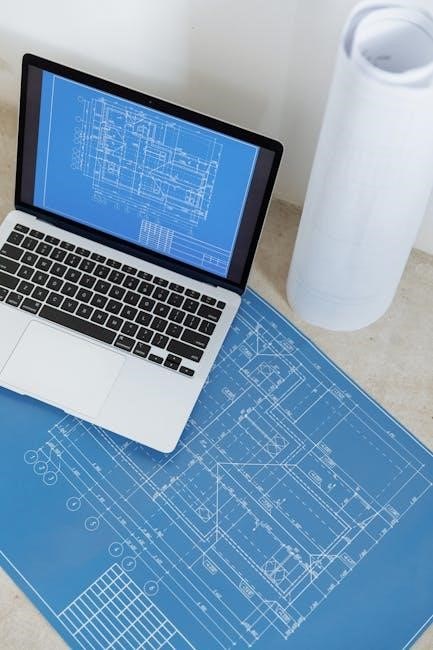
resources and tools, including AWS services, to design and implement solutions, with a focus on best practices and optimization techniques always․
Overview of AWS Certified Solutions Architect Exams
The AWS Certified Solutions Architect exams are designed to validate the skills and knowledge of solutions architects, with a focus on designing and implementing AWS solutions․ The exams are available in two levels: Associate and Professional, each with its own set of requirements and topics․ The Associate level exam, also known as SAA-C03, is intended for individuals who perform a solutions architect role and validates their ability to design solutions based on the AWS Well-Architected Framework․ The Professional level exam, also known as SAP-C02, is intended for individuals who have advanced technical skills and experience in designing optimized AWS solutions․ Both exams cover a range of topics, including designing resilient architectures, selecting appropriate AWS services, and ensuring security and compliance․ By passing these exams, solutions architects can demonstrate their expertise and commitment to designing and implementing effective AWS solutions, and can enhance their career prospects and professional development․ The exams are an important part of the AWS certification program․
AWS Certified Solutions Architect ‒ Associate Exam Guide

The AWS Certified Solutions Architect ― Associate exam guide provides a comprehensive overview of the exam format, content, and requirements․ The guide is designed to help candidates prepare for the exam, which validates their ability to design solutions based on the AWS Well-Architected Framework; The exam guide covers the key topics and domains, including designing resilient architectures, selecting appropriate AWS services, and ensuring security and compliance․ It also provides information on the exam format, question types, and scoring․ The guide is an essential resource for candidates who want to prepare for the exam and demonstrate their skills and knowledge as a solutions architect․ By using the exam guide, candidates can ensure that they are well-prepared for the exam and can improve their chances of passing․ The guide is available online and can be downloaded in PDF format, making it easy to access and use․ The exam guide is a valuable resource for anyone preparing for the AWS Certified Solutions Architect ― Associate exam․

AWS Solutions Architect Study Guide
Provides essential guidance and resources for architects, using various AWS services and tools, to design and implement optimized solutions always effectively and efficiently online․
AWS Collection and Open Source Items
The AWS Collection provides a wide range of open source items, including tools, software, and libraries, that can be used to design and implement AWS solutions․ These items are available for download and can be used to support various AWS services, such as computing, storage, and database services․ The collection includes items such as the AWS SDK, AWS CLI, and AWS CloudFormation, which can be used to manage and deploy AWS resources․ Additionally, the collection includes open source items, such as Apache Spark, Hadoop, and Docker, which can be used to support big data processing, machine learning, and containerization․ The AWS Collection and open source items can be used to support a wide range of use cases, from simple web applications to complex enterprise-level solutions․ By using these items, architects can design and implement optimized AWS solutions that meet the needs of their organization․ The collection is regularly updated with new items and versions, ensuring that architects have access to the latest tools and technologies․
AWS Partner Network and Skill Builder
The AWS Partner Network (APN) is a global community of partners who leverage AWS to build, market, and sell solutions․ To get started, individuals can sign up for an APN account using their business email․ Next, they can sign into AWS Skill Builder as an APN partner, using the credentials from the previous step․ The AWS Skill Builder platform provides a range of learning resources, including video courses, tutorials, and hands-on labs, to help partners develop the skills they need to succeed․ Partners can enroll in the AWS Skill Builder Learning Plan, which provides a structured approach to learning AWS skills․ The plan includes a range of topics, from cloud computing fundamentals to advanced architectures and security․ By leveraging the APN and AWS Skill Builder, partners can develop the skills and expertise they need to deliver high-quality AWS solutions to their customers․ The APN and AWS Skill Builder are essential resources for any organization looking to build a successful AWS practice․

Domain 1: Design Resilient Architectures
Domain 1 focuses on designing resilient architectures, using various AWS services and techniques to ensure high availability and reliability, with a focus on best practices always․
Designing Multi-Tier Architecture Solutions
Designing multi-tier architecture solutions is a critical aspect of creating scalable and efficient systems, using various AWS services such as Amazon EC2, Amazon RDS, and Amazon S3, to ensure high availability and reliability․
The process involves dividing the system into multiple layers, each with its own specific function, such as presentation, application, and data storage․
This approach allows for greater flexibility, scalability, and maintainability, as each layer can be modified or updated independently without affecting the entire system․
Additionally, using AWS services such as Amazon Elastic Load Balancer and Amazon Auto Scaling, architects can ensure that the system is highly available and can handle changes in traffic or demand․
By following best practices and using the right AWS services, architects can design multi-tier architecture solutions that meet the needs of their organization and provide a solid foundation for future growth and expansion․
The use of AWS services and multi-tier architecture solutions can help architects create systems that are highly available, scalable, and efficient, and that meet the needs of! their organization․
Decoupling Mechanisms using AWS Services
Decoupling mechanisms are essential in designing scalable and fault-tolerant systems, and AWS provides various services to achieve this, such as Amazon SQS, Amazon SNS, and Amazon Lambda․
These services enable architects to decouple components and services, allowing them to operate independently and asynchronously․
By using decoupling mechanisms, architects can improve the scalability, reliability, and maintainability of their systems, and reduce the risk of cascading failures․
AWS services provide a range of decoupling mechanisms, including message queues, topic-based messaging, and event-driven computing․
Architects can use these services to decouple components, such as web servers, application servers, and databases, and enable them to operate independently․
This approach allows for greater flexibility, scalability, and fault tolerance, and enables architects to build systems that are highly available and resilient;

By leveraging AWS services and decoupling mechanisms, architects can design systems that are optimized for performance, reliability, and scalability, and that meet the needs of their organization․
The use of decoupling mechanisms is a key aspect of designing scalable and fault-tolerant systems on AWS․



